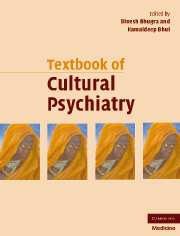Book contents
- Frontmatter
- Contents
- Contributors
- Foreword
- Preface
- Part I Theoretical background
- 1 Cultural psychiatry in historical perspective
- 2 Anthropology and psychiatry: the contemporary convergence
- 3 Suicide, violence and culture
- 4 Psychology and cultural psychiatry
- 5 Spirituality and cultural psychiatry
- 6 Culture, ethnicity and biological psychiatry
- 7 Ethnic inequalities and cultural capability framework in mental healthcare
- Part II Culture and mental health
- Part III Culture and mental disorders
- Part IV Theoretical aspects of management
- Part V Management with special groups
- Part VI Cultural research and training
- Cultural psychiatry: the past and the future
- Index
- References
5 - Spirituality and cultural psychiatry
from Part I - Theoretical background
Published online by Cambridge University Press: 11 August 2009
- Frontmatter
- Contents
- Contributors
- Foreword
- Preface
- Part I Theoretical background
- 1 Cultural psychiatry in historical perspective
- 2 Anthropology and psychiatry: the contemporary convergence
- 3 Suicide, violence and culture
- 4 Psychology and cultural psychiatry
- 5 Spirituality and cultural psychiatry
- 6 Culture, ethnicity and biological psychiatry
- 7 Ethnic inequalities and cultural capability framework in mental healthcare
- Part II Culture and mental health
- Part III Culture and mental disorders
- Part IV Theoretical aspects of management
- Part V Management with special groups
- Part VI Cultural research and training
- Cultural psychiatry: the past and the future
- Index
- References
Summary
EDITORS' INTRODUCTION
Spirituality and religion are core aspects of people's identity in several cultures. This identity allows them to seek help from folk or social sectors and, eventually, from professional sectors. Both spirituality and religion play an important role in shaping an individual's beliefs and behaviours, which may or may not be culturally sanctioned. Clinicians often avoid exploring the patient's spiritual and religious beliefs because of the fear of upsetting them or not being certain as to how to handle them. There are key issues between spirituality and psychiatry, which include those of boundary, those of defining normality or deviance and uncertainty about the role of the other side.
In this chapter, Loewenthal raises four issues that reflect the relationship between psychiatry and spirituality. The first of these is differentiation between religiosity and spirituality. The role of spirituality within psychiatry, differentiation of spiritual and cultural factors and the universalism of these factors are the other issues which Loewenthal addresses in her chapter. There is no doubt that contents of delusions can be influenced by religious factors, but equally managing distress using rituals sanctioned by religions is important in assessment and management. The question of gender and age needs to be addressed further. Anecdotal evidence indicates that females and older people are more religious in their outlook. Religious and spiritual factors also influence help-seeking behaviours. In exclusive religious groups, religious and spiritual resources within the group may be perceived as and followed as providing effective relief from psychological distress. It is obvious that religious and spiritual factors will influence referral and may also reduce stigma.
- Type
- Chapter
- Information
- Textbook of Cultural Psychiatry , pp. 59 - 71Publisher: Cambridge University PressPrint publication year: 2007
References
- 2
- Cited by



